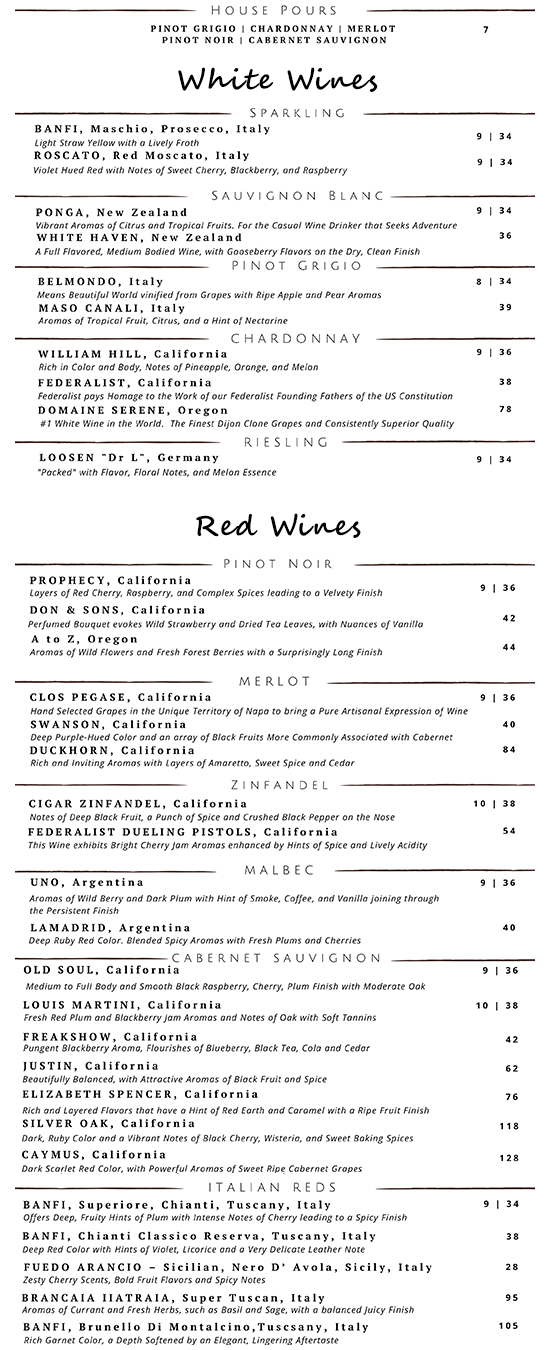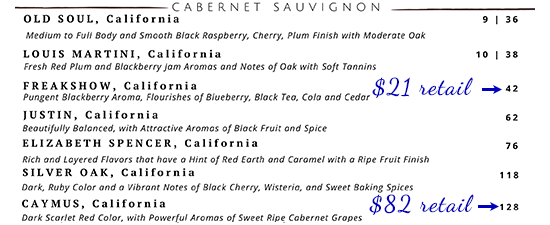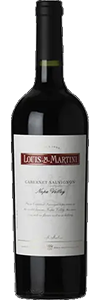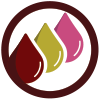Posted by Brent Modzelewski on October 1, 2020
How to read a wine list
Guide to restaurant wine menus
Reading a restaurant wine list can be a stressful event.
When you are seated and handed the menu (and possibly a separate wine list), the server immediately asks you what you would like to drink.
Yikes! This is when the panic sets in.
Don't rush your wine selection.
Just ask for water so you have time to decipher the wine list with the tips listed below.
Let's focus on what I call the Wine Menu, as opposed to a Wine List.
I named it a Wine Menu because it is the wine that is listed on the food menu, typically containing from a few wines to a couple of dozen wines.
Wine Lists I consider to be separate from the food menu and is usually in the form of a book with many pages containing vast choices of wines that could number in the hundreds.
Wine Menus will be broken down into a few categories.
Depending on the cuisine and how extensive the list of wines is, will determine the number categories.
At the very least, it will be broken down into White Wines, Red Wines and House Wines, which can give you a little direction.
It is also common to see Sparkling Wines, Rosé Wines, Dessert Wines and Port Wines on a Wine Menu.
Below is a sample Wine Menu from a restaurant.
As you can see it is broken down into House Pours (house wines), White Wines and Red Wines.
Inside of those categories, they have subcategories.
In fact, they included Sparkling as a subcategory of White Wines.
In this case you would assume that all of the Sparkling wines are white.
However, they have a Red Moscato sparkling wine, which is clearly not white.
The point is, that all wine lists in restaurants are not perfect and only add to why wine is confusing for the everyday consumer.

I would be reluctant to take wine advice from the waiter/waitress. Wine is a complex subject and few servers know much about wine. Their job is to know about the food, not necessarily the wine. In contrast, higher-end restaurants or places with an extensive wine list, will have a Sommelier or other wine expert on staff to aid in wine selection and food pairings. In which case you should absolutely look to them for advice and direction. They will guide you to the best choice for your palate and budget. Most importantly they will have you drinking something you may not have chosen on your own. Take advantage of these wine gurus to expand your knowledge. Without a Sommelier, you will be on your own to figure out the wine available. And this is where these tips will help you. The wine prices are not always obvious. Take a look at the Cigar Zinfandel, it has a price of 10 | 38. This means a glass of wine is $10/glass and a bottle is $38. The Federalist Dueling Pistols Zinfandel only shows a single price of $54, which means it is not sold by the glass.

Noob Tip #1: Avoid the house wines which are "un-named" and sold by the glass. In this case "Mi casa es su casa" is not what you want. The house wines are going to be generic mass-produced low-quality wines that the restaurant buys in large quantities so they can maximize profit on the uniformed.

Noob Tip #2: Rather than a glass of house wine, upgrade yourself to one of the wine they sell by the glass in addition to selling by the bottle. If a restaurant is selling the wine by the glass as well as the bottle, this means the wine was selected to appeal to the masses, but with good enough quality to mention it's brand and a bit about the wine. These are safe bets if you want to try a new type of wine and are only slightly more expensive than the house wines on a per glass basis. Noob Tip #3: Do a little math. There are 5 glasses of wine in a bottle. So if you and your friend are drinking the same wine by the glass, it usually makes more economical sense to buy the bottle, rather than buying 2 glasses each.

Wine Connoisseur Tip #1: As you experience more wine you will begin to develop a mental map of regions around the world that are home to the types of flavor profiles that you like. Once you have this knowledge you will be able to select a new bottle of wine from a region you know and have a pretty good idea what it is going to taste like. At first, this may seem like an impossibility. It is not as hard as you think, but it does take some time to build this mental picture. When you try a new wine for the first time, it is good to note the varietal, the region. If you don't know the specific region, at least list the state or country. Don't know where to make these notes? No problem, we got you covered, record 100 wines in your Wine Journal. In our example, I know I like Sauvignon Blancs from New Zealand more than California or France. With this knowledge, I can be reasonably sure that if I order the bottle of White Haven Sauvignon Blanc that I will enjoy that wine, and I won't be risking $36 on wine that I might not like.

Pro Tip #1: In our example, I know that I like Zinfandel from California, but specifically from Lodi, California. The wine list only lists California for the bottle of Federalist Dueling Pistol Zinfandel. Since I don't know if it is from Lodi, I will not risk $54 on a wine that won't fit my preferred flavor profile. Well...unless someone else is paying for it, then drink up.

Pro Tip #2: Putting together all of your knowledge you may recognize the brand, the region and the wine varietal on the wine list. Then you are sure what you are getting (vintage discussions aside). Look at the Merlot section. I am familiar with the Duckhorn Merlot and I know that is located in Napa Valley, California. I know the profile of the Duckhorn Merlot and can expect black fruit aromas and intense black plum and chocolate flavors. At this level, you have more information about the wine, than the wine menu. You know it is from a specific AVA (American Vinicultural Area) of California and that the tasting notes listed on the menu are suspect. But, you know the wine so it is a solid choice if you are looking for a high-end bottle of wine.

Financial Advisor Tip #1: Prices in restaurants can be as much as double the retail price for the same bottle of wine. Michael David 2018 Freakshow Cabernet Sauvignon retails for about $21 and is priced at $42 on the wine menu. Caymus 2018 Cabernet Sauvignon retails for $82 and is priced at $128 on the wine menu. Actual wine prices can vary greatly with vintage for higher-end wines. This particular Wine Menu does not have vintages listed. Vintages affect the profile just as much as the price.


I would be reluctant to take wine advice from the waiter/waitress. Wine is a complex subject and few servers know much about wine. Their job is to know about the food, not necessarily the wine. In contrast, higher-end restaurants or places with an extensive wine list, will have a Sommelier or other wine expert on staff to aid in wine selection and food pairings. In which case you should absolutely look to them for advice and direction. They will guide you to the best choice for your palate and budget. Most importantly they will have you drinking something you may not have chosen on your own. Take advantage of these wine gurus to expand your knowledge. Without a Sommelier, you will be on your own to figure out the wine available. And this is where these tips will help you. The wine prices are not always obvious. Take a look at the Cigar Zinfandel, it has a price of 10 | 38. This means a glass of wine is $10/glass and a bottle is $38. The Federalist Dueling Pistols Zinfandel only shows a single price of $54, which means it is not sold by the glass.

Noob Tip #1: Avoid the house wines which are "un-named" and sold by the glass. In this case "Mi casa es su casa" is not what you want. The house wines are going to be generic mass-produced low-quality wines that the restaurant buys in large quantities so they can maximize profit on the uniformed.

Noob Tip #2: Rather than a glass of house wine, upgrade yourself to one of the wine they sell by the glass in addition to selling by the bottle. If a restaurant is selling the wine by the glass as well as the bottle, this means the wine was selected to appeal to the masses, but with good enough quality to mention it's brand and a bit about the wine. These are safe bets if you want to try a new type of wine and are only slightly more expensive than the house wines on a per glass basis. Noob Tip #3: Do a little math. There are 5 glasses of wine in a bottle. So if you and your friend are drinking the same wine by the glass, it usually makes more economical sense to buy the bottle, rather than buying 2 glasses each.

Wine Connoisseur Tip #1: As you experience more wine you will begin to develop a mental map of regions around the world that are home to the types of flavor profiles that you like. Once you have this knowledge you will be able to select a new bottle of wine from a region you know and have a pretty good idea what it is going to taste like. At first, this may seem like an impossibility. It is not as hard as you think, but it does take some time to build this mental picture. When you try a new wine for the first time, it is good to note the varietal, the region. If you don't know the specific region, at least list the state or country. Don't know where to make these notes? No problem, we got you covered, record 100 wines in your Wine Journal. In our example, I know I like Sauvignon Blancs from New Zealand more than California or France. With this knowledge, I can be reasonably sure that if I order the bottle of White Haven Sauvignon Blanc that I will enjoy that wine, and I won't be risking $36 on wine that I might not like.

Pro Tip #1: In our example, I know that I like Zinfandel from California, but specifically from Lodi, California. The wine list only lists California for the bottle of Federalist Dueling Pistol Zinfandel. Since I don't know if it is from Lodi, I will not risk $54 on a wine that won't fit my preferred flavor profile. Well...unless someone else is paying for it, then drink up.

Pro Tip #2: Putting together all of your knowledge you may recognize the brand, the region and the wine varietal on the wine list. Then you are sure what you are getting (vintage discussions aside). Look at the Merlot section. I am familiar with the Duckhorn Merlot and I know that is located in Napa Valley, California. I know the profile of the Duckhorn Merlot and can expect black fruit aromas and intense black plum and chocolate flavors. At this level, you have more information about the wine, than the wine menu. You know it is from a specific AVA (American Vinicultural Area) of California and that the tasting notes listed on the menu are suspect. But, you know the wine so it is a solid choice if you are looking for a high-end bottle of wine.

Financial Advisor Tip #1: Prices in restaurants can be as much as double the retail price for the same bottle of wine. Michael David 2018 Freakshow Cabernet Sauvignon retails for about $21 and is priced at $42 on the wine menu. Caymus 2018 Cabernet Sauvignon retails for $82 and is priced at $128 on the wine menu. Actual wine prices can vary greatly with vintage for higher-end wines. This particular Wine Menu does not have vintages listed. Vintages affect the profile just as much as the price.

Wine Nerd Fact Information
BYOW (Bring Your Own Wine)?
Yes, you can bring your own bottle of wine to a restaurant. Not every restaurant will allow you to do this, but the ones that do will provide the proper stemware and storage for your wine, and the waitstaff will open and pour your wine...but that comes at a cost.
That cost is called the Corkage Fee, which typically range from $10-$40.
Be aware that the Corkage Fee is charged per bottle. So, bringing multiple bottles can really rack up some charges.
Restaurants offer this service as a courtesy to patrons that want to enjoy their own special bottle of wine.
It is frowned upon to bring a bottle of wine that is already on the restaurant's wine list, so be aware of this when selecting a bottle to bring.
When you decide to bring a bottle of wine to a restaurant, make it worth your while (and your wallet).
Choosing to bring a $20 bottle of wine that will have a $20 corkage fee doesn't make too much sense.
I highly recommended calling ahead to learn what rules the restaurant imposes around corkage.
Lastly, don't forget to tip your server. Corkage fees go directly to the restaurant, not to the servers. The waitstaff is providing the service of opening, pouring, etc.
Wine2Oh Recommended Wine
Cabernet Sauvignon

Louis M. Martini has an elegant indoor tasting room. There is also a vast outdoor space for both tastings and food/wine pairings. If you visit Napa Valley, this winery should be added to your list to visit.
Louis Martini
2014 Napa Valley
Cabernet Sauvignon
Classic Cabernet Sauvginon aged 18 months in French and American oak barrels. Fruit forward flavors of blueberry, black currant, blackberry with spice and cedar notes. Now is the perfect time to start enjoying this 2014 vintage. Great price for a classic Napa Valley Cab Sauv $35.
Disclaimers: We are not affiliated, sponsored or funded for this blog post. It is purely for the love of wine.
Copyright Great Meadow Products, LLC. All rights reserved.
